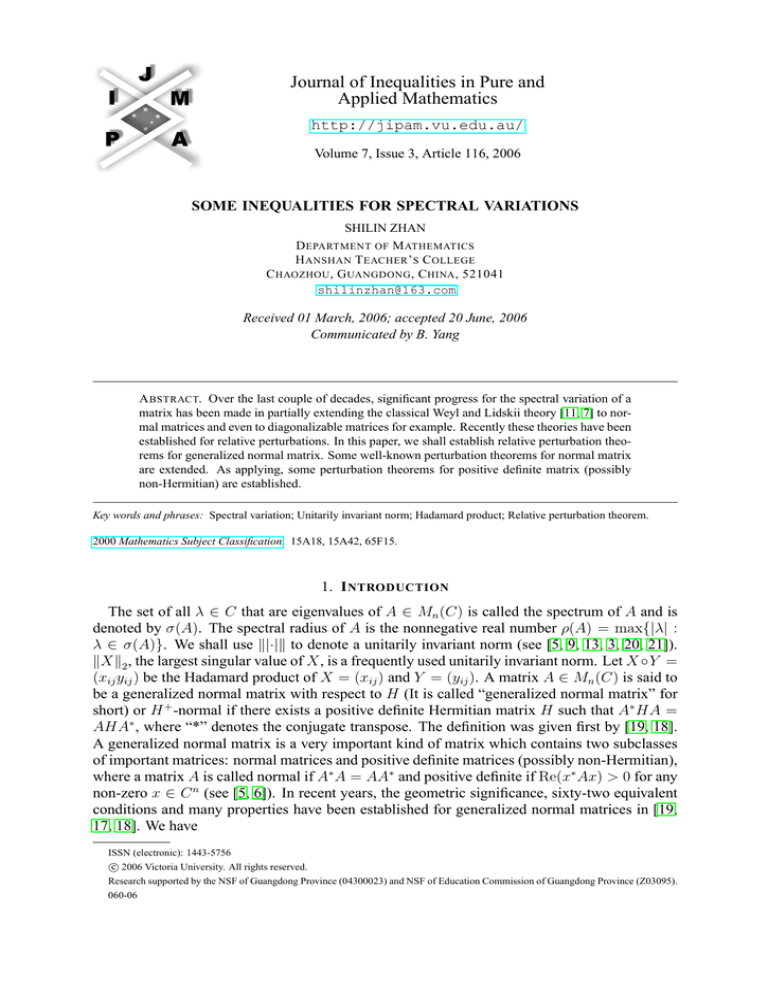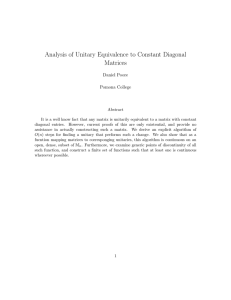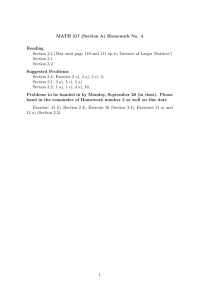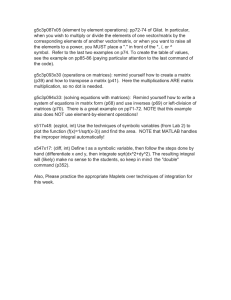
Journal of Inequalities in Pure and
Applied Mathematics
http://jipam.vu.edu.au/
Volume 7, Issue 3, Article 116, 2006
SOME INEQUALITIES FOR SPECTRAL VARIATIONS
SHILIN ZHAN
D EPARTMENT OF M ATHEMATICS
H ANSHAN T EACHER ’ S C OLLEGE
C HAOZHOU , G UANGDONG , C HINA , 521041
shilinzhan@163.com
Received 01 March, 2006; accepted 20 June, 2006
Communicated by B. Yang
A BSTRACT. Over the last couple of decades, significant progress for the spectral variation of a
matrix has been made in partially extending the classical Weyl and Lidskii theory [11, 7] to normal matrices and even to diagonalizable matrices for example. Recently these theories have been
established for relative perturbations. In this paper, we shall establish relative perturbation theorems for generalized normal matrix. Some well-known perturbation theorems for normal matrix
are extended. As applying, some perturbation theorems for positive definite matrix (possibly
non-Hermitian) are established.
Key words and phrases: Spectral variation; Unitarily invariant norm; Hadamard product; Relative perturbation theorem.
2000 Mathematics Subject Classification. 15A18, 15A42, 65F15.
1. I NTRODUCTION
The set of all λ ∈ C that are eigenvalues of A ∈ Mn (C) is called the spectrum of A and is
denoted by σ(A). The spectral radius of A is the nonnegative real number ρ(A) = max{|λ| :
λ ∈ σ(A)}. We shall use k|·|k to denote a unitarily invariant norm (see [5, 9, 13, 3, 20, 21]).
kXk2 , the largest singular value of X, is a frequently used unitarily invariant norm. Let X ◦Y =
(xij yij ) be the Hadamard product of X = (xij ) and Y = (yij ). A matrix A ∈ Mn (C) is said to
be a generalized normal matrix with respect to H (It is called “generalized normal matrix” for
short) or H + -normal if there exists a positive definite Hermitian matrix H such that A∗ HA =
AHA∗ , where “*” denotes the conjugate transpose. The definition was given first by [19, 18].
A generalized normal matrix is a very important kind of matrix which contains two subclasses
of important matrices: normal matrices and positive definite matrices (possibly non-Hermitian),
where a matrix A is called normal if A∗ A = AA∗ and positive definite if Re(x∗ Ax) > 0 for any
non-zero x ∈ C n (see [5, 6]). In recent years, the geometric significance, sixty-two equivalent
conditions and many properties have been established for generalized normal matrices in [19,
17, 18]. We have
ISSN (electronic): 1443-5756
c 2006 Victoria University. All rights reserved.
Research supported by the NSF of Guangdong Province (04300023) and NSF of Education Commission of Guangdong Province (Z03095).
060-06
2
S HILIN Z HAN
Lemma 1.1 (see [19]). Suppose A ∈ Mn (C). Then
(1) A is a generalized normal matrix with respect to H if and only if H 1/2 AH 1/2 is normal.
(2) A is a generalized normal matrix with respect to H if and only if there exists a nonsingular matrix P such that H = (P P ∗ )−1 and
A = P ΛP ∗ ,
(1.1)
where Λ = diag(λ1 , λ2 , . . . , λn ). Furthermore, λ1 , λ2 , . . . , λn are n eigenvalues of HA.
Remark 1.2. (1.1) is equivalent to HA = P −∗ ΛP ∗ with P −∗ = (P −1 )∗ , so we say that A
has generalized eigen-decomposition (1.1), and λ1 , λ2 , . . . , λn are the generalized eigenvalues
of matrix A.
The spectral variation of a matrix has recently been a very active research subject in both
matrix theory and numerical linear algebra. Over the last couple of decades significant progress
has been made in partially extending the classical Weyl and Lidskii theory [11, 16] to normal
matrices and even to diagonalizable matrices for example. This note will show how certain
perturbation problems can be reformulated as simple matrix optimization problems involving
Hadamard products. When A and à are normal, we have shown one of many perturbation theorems that can be interpreted as bounding the norms of Q◦Z where Q is unitary and Z is a special
matrix defined by the eigenalues (see [10]). In this paper, we shall extend the above result, and
shall show how certain perturbation problems can be reformulated as generalized normal matrix
optimization problems involving Hadamard products. Also, we study how generalized eigenvalues of a generalized normal matrix A change when it is perturbed to à = D∗ AD, where
D is a nonsingular matrix. As applications, some perturbation theorems for positive definite
matrices (possibly non-Hermitian) are established.
2. M AIN R ESULT
Suppose that A and à are generalized normal matrices with respect to a common positive
definite matrix H, and have generalized eigen-decompositions
A = P ΛP ∗
and
Λ = diag(λ1 , λ2 , . . . , λn )
and
(2.1)
à = P̃ Λ̃P̃ ∗ ,
where
(2.2)
Λ̃ = diag(λ̃1 , λ̃2 , . . . , λ̃n )
and λi are the generalized eigenvalues of A, and λ̃i are the generalized eigenvalues of à (i =
1, 2, . . . , n).
Notice H = (P P ∗ )−1 and H = (P̃ P̃ ∗ )−1 , so (P −1 P̃ )∗ (P −1 P̃ ) = P̃ ∗ H P̃ = I, then Q =
P −1 P̃ is unitary and
(2.3)
P̃ = P Q
Define
(2.4)
n
Z1 = λi − λ̃j
.
i,j=1
We have the following result.
Theorem 2.1. Suppose A and à are H + -normal with generalized eigen-decomposition (2.1),
Then
−1
(2.5)
ρ(H) k|Q ◦ Z1 |k ≤ A − Ã ≤ ρ(H −1 ) k|Q ◦ Z1 |k ,
where Q = P −1 P̃ is unitary and Z1 is defined in Eq.(2.4).
J. Inequal. Pure and Appl. Math., 7(3) Art. 116, 2006
http://jipam.vu.edu.au/
I NEQUALITIES FOR S PECTRAL VARIATIONS
3
Proof. For A and à having generalized eigen-decomposition (2.1), noticing that P̃ = P Q,
where Q = P −1 P̃ is unitary, k|W Y |k ≤ kW k2 k|Y |k and k|Y Z|k ≤ k|Y |k kZk2 (see [9, p.
961]), we have
∗
∗ ∗ ∗ P ΛP − P QΛ̃Q P ≤ kP k2 Λ − QΛ̃Q kP ∗ k2 ,
then
Since
A − Ã ≤ H −1 2 Λ − QΛ̃Q∗ .
∗ Λ − QΛ̃Q = ΛQ − QΛ̃ = k|Q ◦ Z1 |k
and kH −1 k2 = ρ(H −1 ),
A − Ã ≤ ρ(H −1 ) k|Q ◦ Z1 |k .
(2.6)
On the other hand, we have
−1 ∗
∗ ∗ −∗ ∗ P P
ΛP
−
P
Q
Λ̃Q
P
Λ
−
Q
Λ̃Q
P
≥
2
2
= k|Q ◦ Z1 |k .
p
Similarly for H = (P P ∗ )−1 and kP −1 k2 = kP −∗ k2 = ρ(H), we obtain
ρ(H) A − Ã ≥ k|Q ◦ Z1 |k ,
hence
A − Ã ≥ ρ(H)−1 k|Q ◦ Z1 |k .
(2.7)
The inequality (2.5) completes the proof by inequalities (2.6) and (2.7).
In particular, if H = I is the identity matrix, then H + -normal matrices A and à are normal
matrices, hence A and à have eigen-decomposition
A = U ΛU ∗
(2.8)
and
à = Ũ Λ̃Ũ ∗ ,
where U and Ũ are unitary, and
Λ = diag(λ1 , λ2 , . . . , λn ),
Λ̃ = diag(λ̃1 , λ̃2 , . . . , λ̃n ).
By Theorem 2.1, we have
Corollary 2.2 (see [10]). If A and à are normal matrices, then
(2.9)
A
−
Ã
= k|Q ◦ Z1 |k ,
n
.
where Q = U ∗ Ũ and Z1 = λi − λ̃j
i,j=1
We denote the Cartesian decomposition X = H(X) + K(X), where H(X) = 12 (X + X ∗ ),
and K(X) = 12 (X − X ∗ ). Let σ (H (A)) = {h1 , h2 , . . . , hn } be ordered so that h1 ≥ h2 ≥
· · · ≥ hn . Then we have some perturbation theorems for positie definite matrices which are
discussed as follows.
Corollary 2.3. If A = H(A) + K(A) and à = H(Ã) + K(Ã) are positive definite with
generalized eigen-decomposition (2.1), and Q = P −1 P̃ is unitary, then
(2.10)
hn k|Q ◦ Z1 |k ≤ A − Ã ≤ h1 k|Q ◦ Z1 |k ,
where Z1 is defined in Eq.(2.4).
J. Inequal. Pure and Appl. Math., 7(3) Art. 116, 2006
http://jipam.vu.edu.au/
4
S HILIN Z HAN
Proof. Since Q = P −1 P̃ is unitary, H(A) = H(Ã). It is easy to see that
A∗ H(A)−1 A = AH(A)−1 A∗
and
Ã∗ H(Ã)−1 Ã = ÃH(Ã)−1 Ã∗ .
So A and à are generalized normal matrices with respect to H(A)−1 . It is easy to see that
ρ(H(A)−1 )−1 = hn , ρ(H(A)) = h1 . Applying Theorem 2.1, inequality (2.10) completes the
proof.
Let B, C ∈ Mn (C). Then [B, C] = BC − CB is called a commutator and [B, C]H =
BHC − CHB is called a commutator with respect to H. The matrices B and C are said to
commute with respect to H iff [B, C]H = 0. kXkF is the Frobenius norm.
Corollary 2.4. Let A and à be H + -normal matrices. If A and à commute with respect to H,
then
−1
(2.11)
ρ(H) k|I ◦ Z1 |k ≤ A − Ã ≤ ρ(H −1 ) k|I ◦ Z1 |k ,
where I is the identity matrix, and Z1 is defined in Eq.(2.4).
Proof. [A, Ã]H = 0 if and only if there exists a nonsingular matrix P , such that A = P ΛP ∗ and
à = P Λ̃P ∗ , where Q = P −1 P = I (see [17, Theorem 3] and Theorem 2.1). So Q is taken as
the identity matrix I in Theorem 2.1, hence Eq. (2.11) holds.
Applying Corollary 2.3 and Corollary 2.4, we have
Corollary 2.5. Let the hypotheses of Corollary 2.3 hold. Moreover if matrices A and à commute with respect to H(A)−1 , then
(2.12)
hn k|I ◦ Z1 |k ≤ A − Ã ≤ h1 k|I ◦ Z1 |k ,
where h1 = max1≤i≤n λi (H(A)), hn = min1≤i≤n λi (H(A)) and Z1 is defined in Eq.(2.4).
In the following, we shall study how generalized eigenvalues of a generalized normal matrix
A change when it is perturbed to à = D∗ AD, where D is a nonsingular matrix. The p−relative
distance between α, α̃ ∈ C is defined as
|α − α̃|
%p (α, α̃) = p
p
(2.13)
|α|p + |α̃|p
for 1 ≤ p ≤ ∞.
Theorem 2.6. Suppose A and à are H + -normal matrices and à = D∗ AD, where D is nonsingular. Let A and à have generalized eigen-decomposition (2.1). Then there is a permutation
τ of {1, 2, . . . , n} such that
n
X
(2.14)
2
[%2 (λi , λ̃τ (i) )]2 ≤ c(kI − Dk2F + D−∗ − I F )
i=1
where c = max1≤i≤n λi (H)/ min1≤i≤n λi (H).
Proof. Notice that
A − Ã = A − D∗ AD = A(I − D) + (D−∗ − I)Ã.
Pre- and postmultiply the equations by P −1 and P̃ −∗ respectively, to get
(2.15)
ΛP ∗ P̃ −∗ − P −1 P̃ Λ̃ = ΛP ∗ (I − D)P̃ −∗ + P −1 (D−∗ − I)P̃ Λ̃.
J. Inequal. Pure and Appl. Math., 7(3) Art. 116, 2006
http://jipam.vu.edu.au/
I NEQUALITIES FOR S PECTRAL VARIATIONS
5
Set Q = P −1 P̃ = (qij ), then Q is unitary and Q = P ∗ P̃ −∗ . Let
(2.16)
E = P ∗ (I − D)P̃ −∗ = (eij ), Ẽ = P −1 (D−∗ − I)P̃ = (ẽij ).
Then (2.15) implies that ΛQ− QΛ̃ = ΛE + Ẽ Λ̃ or componentwise λi qij − qij λ̃j = λi eij + ẽij λ̃j ,
so
2
2
2 2
2
2
(λi − λ̃j )qij = λi eij + ẽij λ̃j ≤ (|λi | + λ̃j )(|eij | + |ẽij | ),
which yields [%2 (λi , λ̃j )]2 |qij |2 ≤ |eij |2 + |ẽij |2 . Hence
n
X
[%2 (λi , λ̃j )]2 |qij |2
i,j=1
2 2
∗
−1 −∗
−∗ ≤ P (I − D)P̃ + P (D − I)P̃ F
F
2 2 2
2
2
2
∗
−∗
−1 −∗
≤ kP k2 kI − DkF P̃ + P
D − I F P̃ .
2
2
2
Notice that
kP ∗ k22
= max λi (H) and
1≤i≤n
−1 2
P =
2
−1
min λi (H)
1≤i≤n
2
by σ(P P ∗ ) = σ(P ∗ P ) = σ(H). Similarly, we have P̃ = max1≤i≤n λi (H) and
2
−∗ 2
P̃ = max1≤i≤n λi (H −1 ) =
2
−1
min λi (H)
,
1≤i≤n
so
n h
X
i2
2 %2 λi , λ̃j
|qij |2 ≤ c kI − Dk2F + D−∗ − I F ,
i,j=1
where c = max1≤i≤nλi (H)/min1≤i≤n λi (H).
The matrix |qij |2 n×n is a doubly stochastic matrix. The above inequality and [9, Lemma
5.1] imply inequality (2.14).
If A and à are normal matrices, then they are generalized normal matrices with respect to H
and H = I. Applying Theorem 2.6, it is easy to get
Corollary 2.7. If A, à ∈ Mn (C) are normal matrices with A = U ΛU ∗ and à = Ũ Λ̃Ũ ∗ where
both U and Ũ are unitary, and à = D∗ AD, where D is nonsingular, then
n
X
(2.17)
2
[%2 (λi , λ̃τ (i) )]2 ≤ kI − Dk2F + D−∗ − I F .
i=1
Corollary 2.8. Let A = H(A) + K(A) and à = H(Ã) + K(Ã) be positive definite matrices
with generalized eigen-decomposition (2.1), and à = D∗ AD, where D is nonsingular. If
Q = P −1 P̃ is unitary, then
n h
i2
X
2 (2.18)
%2 λi , λ̃τ (i)
≤ c kI − Dk2F + D−∗ − I F ,
i,=1
where c = max 1≤i≤n λi (H(A))/ min 1≤i≤n λi (H(A)).
J. Inequal. Pure and Appl. Math., 7(3) Art. 116, 2006
http://jipam.vu.edu.au/
6
S HILIN Z HAN
Proof. By the proof of Corollary 2.3, A and à are generalized normal matrices with respect to
H(A)−1 , and
max λi (H(A)−1 )/ min λi (H(A)−1 ) = max λi (H(A))/min1≤i≤n λi (H(A)).
1≤i≤n
1≤i≤n
1≤i≤n
Inequality (2.18) is proved by Theorem 2.6.
R EFERENCES
[1] T. ANDO, R.A. HORN AND C.R. JOHNSON, The singular values of a Hadamard product: a basic
inequality, Linear and Multilinear Algebra, 87 (1987), 345–365.
[2] S.C. EISENSTAT AND I.C.F. IPSEN, Three absolute perturbation bounds for matrix eigenvalues
imply relative bounds, SIAM J. Matrix Anal. Appl., 20 (1999).
[3] F. HIAI AND X. ZHAN, Inequalities involving unitarily invariant norms and operator monotone
functions, Linear Algebra Appl., 341 (2002), 151–169.
[4] J.A. HOLBROOK, Spectral variation of normal matrices, Linear Algebra Appl., 174 (1992), 131–
144.
[5] R.A. HORN AND C.R. JOHNSON, Matrix Analysis, Cambridge University Press, 1985.
[6] C.R. JOHNSON, Positive definite matrices, Amer. Math. Monthly, 77 (1970), 259–264.
[7] REN-CANG LI, Spectral variations and Hadamard products: Some problems, Linear Algebra
Appl., 278 (1998), 317–326.
[8] C.-K. LI AND R. MATHIAS, On the Lidskii-Mirsky-Wielandt theorem, Manuscript, Department
of Mathematics, College of William and Mary, 1996.
[9] REN-CANG LI, Relative perturbation theory: (1) eigenvalue and singular value variations, Technical Report UCB// CSD-94-855, Computer Science Division, Department of EECS, University of
California at Berkeley, 1994. Also LAPACK working notes 85 (revised January 1996, available at
http://www..netlib.org/lapack/lawns/lawn84.ps).
[10] REN-CANG LI, Spectral varitions and Hadamard products: Some problems, Linear Algebra Appl.,
278 (1998), 317–326.
[11] V.B. LIDSKII, The Proper values of the sum and product of symmetric matrices, Dokl. Akad. Nauk
SSSR, 75 (1950), 769–772. [In Russian, Translation by C. Benster, available from the National
Translation Center of the Library of Congress.]
[12] R. MATHIAS, The singular values of the Hadamard product of a positive semidefinite and a
skewsymmetric matrix, Linear and Multilinear Algebra, 31 (1992), 57–70.
[13] L. MIRSKY, Symmetric gauge functions and unitarily invariant norms, Quart. J. Math., 11 (1960),
50–59.
[14] J.-G. SUN, On the variation the spectrum of a normal matrix, Linear Algebra Appl., 246 (1996),
215–223.
[15] N. TRAUHAR AND I. SLAPNICAR, Relative perturbation bound for invariant subspaces of graded
indefinite Hermitian matrices, Linear Algebra Appl., 301 (1999), 171–185.
[16] H. WEYL, Das asymptotische verteilungsgesetz der eigenwerte linearer partieller differentialgleichungen (mit einer anwen dung auf die theorie der hohlraumstrahlung), Math. Ann., 71 (1912),
441–479.
[17] SHILIN ZHAN, The equivalent conditions of a generalized normal matrix, JP Jour. Algebra, Number Theory and Appl., 4(3) (2004), 605–619.
J. Inequal. Pure and Appl. Math., 7(3) Art. 116, 2006
http://jipam.vu.edu.au/
I NEQUALITIES FOR S PECTRAL VARIATIONS
7
[18] SHILIN ZHAN, Generalized normal operator and generalized normal matrix on the Euclidean
Space, Pure Appl. Math., 18 (2002), 74–78.
[19] SHILIN ZHAN AND YANGMING LI, The generalized normal Matrices, JP Jour. Algebra, Number
Theory and Appl., 3(3) (2003), 415–428.
[20] X. ZHAN, Inequalities for unitarily invariant norms, SIAM J. Matrix Anal. Appl., 20 (1998), 466–
470.
[21] X. ZHAN, Inequalities involving Hadamard products and unitarily invariant norms, Adv. Math.
(China), 27 (1998), 416–422.
J. Inequal. Pure and Appl. Math., 7(3) Art. 116, 2006
http://jipam.vu.edu.au/








